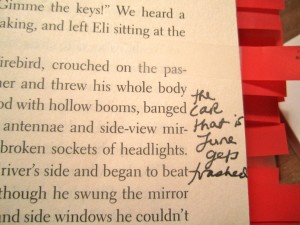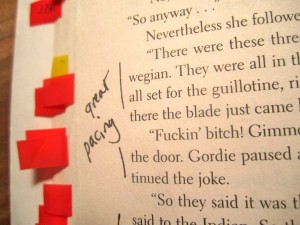My mother’s mystery
Michele Filgate, editor of the gorgeous anthology What My Mother and I Don’t Talk About (Simon & Schuster, 2019), included this essay about my mother and her intense “friendship” with the abstract painter Haywood “Bill” Rivers. My mother knew Rivers before she met my father, but she spoke of him to me through much of my life.
I think she concealed as she much as she revealed. Including the ending. And her regrets.
And it may have mattered, for the end of her 1950s-era story, that she was white and Bill Rivers was Black.
Soon after this essay appeared in the antho and here on longreads.com, a researcher mailed me two typewritten letters he’d found in an archive from my mother to Bill Rivers. Reading them, I could feel how she’d loved him, despite her sparky tone; I could see that this “friendship” was in truth an affair.
It’s no longer new. But I’ve been thinking about it lately because Michele is doing a new antho, What My Father and I Don’t Talk About. If you follow the link, I hope you enjoy the work.
Grief and Reading
The New York Times Book Review published my essay on reading–or, rather, on ceasing to read–as my parents became increasingly ill and then passed away in 2014.
New Page After Page Workshops July 25-26, 2015
Offered in a beautiful apartment in Greenwich Village, with inspiring views of the city, our workshops are productive, focused, and lively.
We’re writers (15+ books between us). And we’re passionate, committed teachers, eager to pass along what we’ve learned (combined, 40+ years of writing, editing, publishing, and teaching).
Our co-taught classes are intimate and personal. During the course of the day we talk deeply about craft and technique (handouts, materials, and chocolate provided) and also about process—how to prepare for a productivewriting session, how to get un-stuck, how to revise effectively. The atmosphere is supportive, positive, and kind. Courses are content-rich and interactive, combining instruction and practice, discussion and response.
Every workshop we teach allows time for Q & A so each student’s questions are answered, fully. You’ll leave with new work and new energy for your creative projects, a pile of exercises, and a list of books to read.
Saturday, July 25, 10 am – 5 pm $325
Creative Flow: Writing in Deep Focus
Discover how writers tap into creative flow. Learn how to harness the power of the unconscious and access “writer’s mind.” Working intentionally to maintain creative flow means fewer drafts and less frustration. You truly can work more efficiently and more effectively with a deeper awareness of the practices that support concentration. In this one-day workshop, through a sequence of in-class writing exercises, discover six simple, practical techniques to increase your powers of concentration and focus.
Sunday, July 26, 9:30 am – 1:30 pm $275
Micro-Memoir Writing Intensive
Micro-memoir is a powerful,shapely personal narrative—in 750 words or fewer. Hone your ability to compress, focus, and write tight. And learn how litany, structure, and crisp use of detail can interlock in this exhilarating form. We work hard and the atmosphere is inspiring and encouraging. During the workshop, you’ll draft three pieces using new strategies. We offer guidance and suggest prompts—but you are free to write what you wish. We’ll present unique approaches for revision. And we’ll give you tips for publishing these short essays.
Both Workshops $540
Creative Flow is not a prerequisite for any of our other courses. We always welcome our returning students.
Your check holds your place. Refund if we can fill your spot.
Please contact Heather Sellers at heatherellesellers@gmail.com or Dylan Landis at dylanlandis@gmail.com.
A private workshop intensive in NYC: Summer 2014
FLASH FICTION & MICRO-MEMOIR: a one-day writing intensive
Heather Sellers and Dylan Landis, Instructors
Saturday, July 26, 10 am – 5 pm
Greenwich Village, New York
Flash fiction and micro-memoir are powerful, shapely narratives—in 750 words or fewer. In a workshop with intensive one-on-one feedback, hone your ability to compress, to focus, and to write tight. And learn how character, plot, and crisp use of detail can interlock in this exhilarating form.
Participants submit a short-short in advance and receive a detailed professional line-edit in class. During the workshop, you’ll learn three core strategies for revision, and start a new piece. We also examine the fertile marketplace for publishing these intense short essays and stories. We work hard and the atmosphere is inspiring and encouraging. You’ll leave with clearly, thoroughly revised work, road maps for your next fiction or memoir pieces, and prompts to launch new work.
Contact heatherellesellers @ gmail.com or dylanlandis @ gmail.com for more information or to enroll.
Private Workshop Intensives in NYC, Spring 2014
I.
CREATIVE FOCUS: A one-day intensive for memoir and fiction writers
waitlisted!
Saturday May 10, 2014
10 a.m. – 5 p.m. in a private Greenwich Village home
$300
Improve the quality and depth of your work by learning how to practice creative focus. Discover how writers harness the power of the unconscious and access “writer’s mind.” Fewer drafts, less frustration—we can work more efficiently and more effectively as we deepen our awareness of our subconscious creative potential. In this one-day workshop, through a sequence of in-class writing exercises, you’ll learn six simple, practical techniques to increase your powers of concentration and focus, jumpstart a work-in-progress, launch new work, and enrich a scene in revision.
II.
TALK TO ME: A one-day intensive for memoir and fiction writers
Saturday May 17, 2014
With apologies this workshop has been postponed.
10 a.m. – 5 p.m. in a private Greenwich Village home
$300
Everything you need to create powerful prose can be honed by studying dialogue. Everything critical to memoir and fiction—character, conflict, plot, setting, subtext—is interwoven with dialogue. In this one-day intensive we’ll examine dialogue by contemporary and classic authors and discuss the three techniques that give dialogue its power to create the spine of a scene. We’ll write scenes that jumpstart new work or continue a work in progress. And we’ll learn a critical technique for accessing the subconscious and channeling the voices of your characters.
For more information or to enroll
We’re writers (15+ books between us). And we’re passionate, committed teachers, eager to pass along what we’ve learned (combined, 40+ years of writing, publishing, and teaching). We would like to invite you to our small private workshops in New York City.
Our co-taught classes are intimate (always limited to six) and personal. Students gather around a gorgeous Art Deco table in a Greenwich Village home. During the course of the day we talk deeply about craft and technique (handouts, materials, and chocolate provided) and also about process—how to prepare for a writing session, how to get un-stuck, how to revise effectively. The atmosphere is supportive, positive, and kind. But we work hard: courses are content-rich and interactive, combining instruction and practice, discussion and critique.
Together, we study stellar writers, both classic and contemporary, and we’ll write in class, and respectfully discuss each other’s work. Every workshop we teach allows time for Q & A so each student’s questions are answered, fully. You’ll leave with new work and new energy for your creative projects, a pile of exercises, and a list of books to read.
You’ll learn to write more efficiently, to get more from the time you can spare to write in your daily life, and to concentrate and stay focused, so you spend less time in revision. At the end of the day, you’ll have the tools you need to jumpstart new work and keep it flowing on your own.
*
Our one-day Saturday workshop intensives are $300 per person.
Your check reserves your spot.
Real life happens. Full refund if we fill your spot from the wait list.
Class size is limited to six.
Class starts at 10 am sharp; doors open at 9:45 am.
Our morning and afternoon sessions are punctuated by short breaks (coffee and tea will be available) and divided by ample time for lunch on your own at a local restaurant (or gathered around the table, as you wish).
Class concludes at 5 pm.
For more information or to enroll contact
Throwing stones
This post appeared on Andrew’s Book Club during Short Story Month–May, 2011. I’m reposting (with revision) in June because that’s how slowly this blog moves.
FIRST get your character up a tree. Then throw stones at him.
Who said that first? I’ve been repeating it for years. I’d tattoo it up one arm and down the other if it would make my stories as trouble-filled as “Virgins,” the opening story in Danielle Evans’s debut collection, Before You Suffocate Your Own Fool Self. It first ran in the Paris Review, then was selected for Best American Short Stories 2008.
Tree, stones:
Two Mount Vernon girls, Erica and Jasmine, lie to their mothers and take their cousins’ I.D.s to go clubbing in New York City. They also bring Michael, their friend and guardian angel. He keeps trouble, in the form of other guys, away.
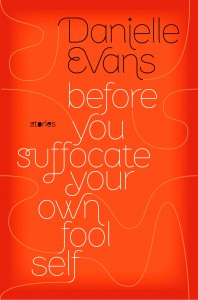 Erica likes a good time but she’s not rushing to grow up. Whereas Jasmine’s been lugging a suitcase of anger and hurt for months, since a friend of Michael’s took her virginity and ditched her.
Erica likes a good time but she’s not rushing to grow up. Whereas Jasmine’s been lugging a suitcase of anger and hurt for months, since a friend of Michael’s took her virginity and ditched her.
Here is the difference between Erica and Jasmine: Early in the story, at a movie theatre, they spot the guy who deflowered Jasmine. He’s got both hands deep in the hair of his new girlfriend and they’re kissing–deeply, intensely and in the middle of a crowded theatre lobby. Jasmine demands,
“When are we going to be that kind of girl?”
And Erica says,
“What, the stupid kind?”
At the club in Manhattan, the bouncer waves the girls in but turns Michael away cold. (This was the base of the tree, for me: two underage girls stranded in an adult club without their protector, Erica feeling, then burying, her anxiety.)
They dance—sexually, grinding—with men who come up behind them. Then they hit the bar. Erica pretends to be a college student. It’s mobbed; they get separated. (Stranded again, she’s higher up the tree.) Erica pretends to be a record store clerk, then a newspaper photographer, letting men buy her drinks.
Eventually, she finds Jasmine flirting with four men, bombed.
We’re going to an after party, Jasmine says. In the Bronx.
Alarmed, Erica says no, but things happen too fast. Someone has an arm around her. The valet brings a car around and the men get in. Jasmine sits on someone’s lap and drapes her arms around his neck. (Erica, high in the tree, is afraid to leave Jasmine.)
With seconds to make up her mind, she squeezes into the backseat.
(She’s now so far up the tree she seems stuck—indeed, she’s in a crucible–at which point the writer needs the guts to pick up a slingshot.)
Jasmine tongue-kisses the guy whose lap she’s on, escalating the situation as the car speeds toward the Bronx. (Stone.)
The man sitting shotgun informs Erica that she has an “attitude problem,” making clear that the balance of power has further slipped. (Stone.)
The man says,
“Y’all are probably virgins, aren’t you?”
–intimating that the evening is far, far out of the girls’ hands. (Stone.)
Jasmine retorts,
“Like hell we are.”
–signing away whatever may have been left of Erica’s autonomy. (Stone.)
And Jasmine’s lying; Erica’s a virgin. But in a sense, so is Jasmine; she’s a naïf when it comes to trouble this ugly, and innocence is what she’ll lose tonight.
They park outside an apartment building near a bodega. They enter a lobby, then an elevator. (Skull-cracking stone.)
Someone presses eight. (Stone.)
Erica considers an act of violence, about hitting Jasmine or pulling her guy off of her.
The doors open on five.
Evans stops time for the critical seconds the door is open. Here’s Erica, in those seconds:
There was nobody standing there and I kept waiting for the thing that would stop us, and then I thought, Nothing will stop this but me.
And she bolts.
(Stone for Jasmine, now alone: Will she be gang-raped? Will it be brutal? Will they let her go?)
Erica runs down the stairwell and out to the bodega. She calls Michael. It’s two-thirty in the morning. A lesser writer might resolve the tension here, but Evans throws a final stone, forcing Erica to one more decision.
I love how the story left me cleaved at the end. Weeks after reading I’m still halfway down a staircase in the Bronx, late at night, relieved to be free—yet also trapped in an apartment with Jasmine, hearing the lock click and the men laugh.
Tree, stones.
I’m grateful to be reminded:
Throw hard.
Love Medicine: some lessons on linked stories
I wrote my own book of linked stories by accident.
It started with one story about a girl named Leah, age 11. It was my first short story and took four months to write (not enough time, as it turned out), and took place in the basement of her building in New York City. When it was finished, I felt I knew Leah.
That seemed worth building on, and easier than starting fresh with a stranger, so I wrote a second story about her. This time she was twelve and up against a mean girl named Rainey.
Then I wrote a story about Rainey, at 13, with the man who abused her.
Then Leah again, with her best friend, at 15.
After five years I had a book—a novel-in-stories. It was called Normal People Don’t Live Like This. 
You could attribute the linkages to a total failure of imagination, as I admitted at the AWP panel on “Linking It Up: Working with Story Cycles, Linked Collections, and Novels-in-Stories” (with Anne Sanow, Clifford Garstang and Cathy Day). When Anne invited me onto that panel, I thought I knew what a link was: any person, object, situation, place that repeats between two or more short stories.
Still. I began rereading linked collections, among them Harriet Doerr’s Stones for Ibarra, Tim O’Brien’s The Things They Carried, Elissa Schappell’s Use Me, and Love Medicine, by Louise Erdrich, 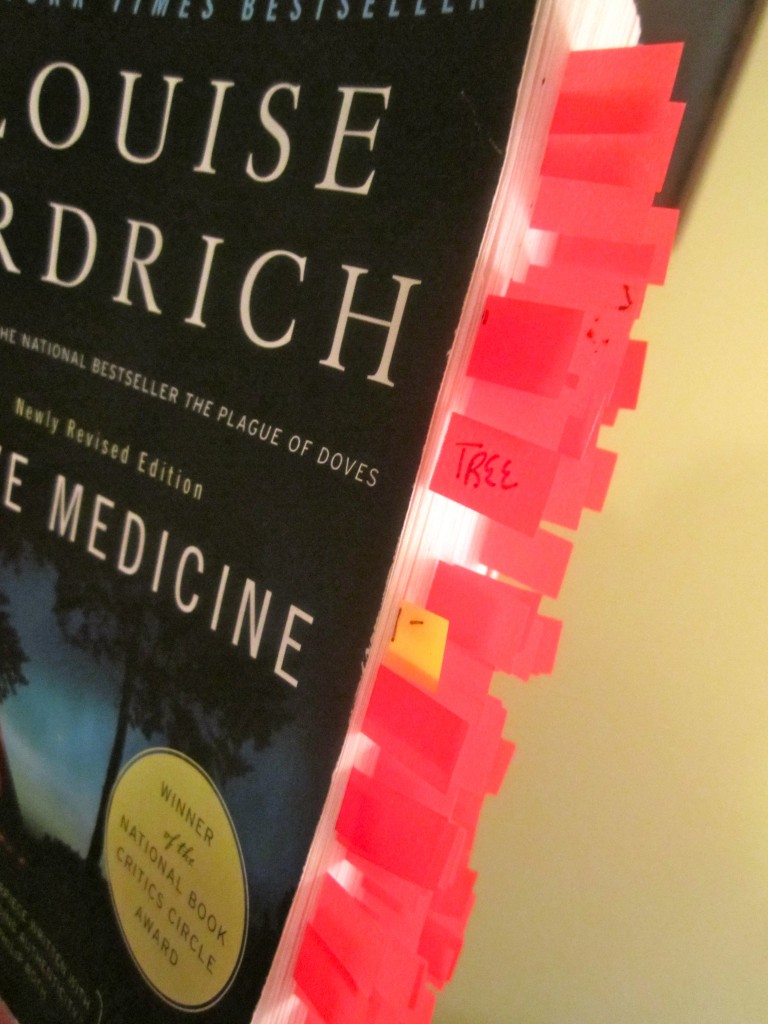 to see what I didn’t know. Sometimes, when you are in dire need of a craft lesson, one book opens itself up like a flower for your inspection, and for me, that book was Love Medicine. It revealed that stories can be crocheted together so intricately and dimensionally that they form a kind of lacework.
to see what I didn’t know. Sometimes, when you are in dire need of a craft lesson, one book opens itself up like a flower for your inspection, and for me, that book was Love Medicine. It revealed that stories can be crocheted together so intricately and dimensionally that they form a kind of lacework.
It made my own linked stories look like a child’s paper chain.
Here are just a few things Erdrich showed me. The examples won’t make much sense without the text—but close-reading has been the main way I’m able to limp forward as a writer.
Note: the tiny Post-Its in my copy, above, note each appearance and reappearance of a link, except for the obvious: characters, who continually reappear, and place. Most of the book occurs on a Chippewa reservation in North Dakota.
Put the engine of the book up front. This story be the hub or contain the underlying or dominant link. (Cliff Garstang on our panel called this the umbrella story.)
The first and most powerful link in Love Medicine is a person: June Kashpaw, a Chippewa woman who dies early in the first story. June left behind a legitimate family, husband Gordie Kashpaw and son King; and an illegitimate family, lover Gerry Nanapush and son Lipsha. She also left behind a whole lot of tension. Lipsha doesn’t know who his parents are, but everyone else does.
The first story has broad swaths of backstory. I’m always bad at this. I’ve been reading lots of Andrea Barrett, because Dick Bausch says that Andrea Barrett calls this ELEGANT SUMMARY.
Every character in the book is impacted by June’s death, which is what makes this first story—in which she dies—the engine.
The central imagery—of water, and crossing water (which refers to both dying and coming home), begins here too.
Even when it started to snow she did not lose her sense of direction. Her feet grew numb, but she did not worry about the distance. The heavy winds couldn’t blow her off course. Even when her heart clenched and her skin turned crackling cold it didn’t matter, because the pure and naked part of her went on.
The snow fell deeper that Easter than it had in forty years, but June walked over it like water and came home.
This engine-up-front occurs in other linked collections, though not in mine, and has the effect of orienting the reader. We meet all the soldiers in the first and title story of The Things They Carried, and learn what matters most to each, and where they are and what they do.
In my collection’s first story, we meet a compelling character who reappears only once, then vanishes.
Make links kinetic so that they grow in power, and change, each time they recur.
Here is an Erdrich object-link that’s loaded and reloaded with emotional freight early on:
In the first story, June’s son, King Kashpaw, uses the insurance money from her death to buy a sportscar. Her relatives keep their distance, as if the car might be a ghost:
Nobody leaned against the shiny blue fenders, rested elbows on the hood, or set paper plates there while they ate. Aurelia didn’t even want to hear King’s tapes. It was as if the car was wired up to something. As if it might give off a shock when touched. Later, when Gordie came, he brushed the glazed chrome and gently tapped the tires with his toes. He would not go riding in it either, even though King urged his father to experience how smooth it ran.
Erdrich doesn’t stop there; she increases the freight. King drinks, becomes abusive, and chases his wife, Lynette, outside. Lynette locks herself in the sportscar, and King rips off a side mirror and beats the car. Finally Gordie, his father, grabs him to the ground in a hug and says,
“It’s her car. You’re June’s boy, King. Don’t cry.”
For as they lay there, welded in shock, King’s face was grinding deep into the cinders and his shoulders shook with heavy sobs. He screamed up through dirt at his father.
“It’s awful to be dead. Oh my God, she’s so cold.”
So when the car reappears near the end of the book, it really IS June; we believe that it means everything to King. But Erdrich doesn’t just use it as a link; she raises the stakes. Here’s how.
In the final story, Gerry (June’s lover) shows up in King’s apartment to get revenge. The two had been cellmates till Gerry escaped—and King ratted him out. Now King is terrified of Gerry. Lipsha’s in the apartment, too, and King hates Lipsha, his mother’s ill-gotten son.
Lipsha, for his part, has finally been told who his parents are: June and Gerry. He’s dying to declare himself to Gerry. And as tension builds, he’s handling a deck of cards, quietly nicking the edges with his fingernails.
Link no. 1: the sportscar. The men play poker. Lipsha insists they play for King’s car—for the car that is June, really. Lipsha wins the car.
Erdrich freights the link yet again by having the police show up, looking for Gerry. Gerry disappears out the window: just vanishes. Lipsha, driving away in King’s car, discovers that Gerry is in the trunk. He drives him all the way to Canada, to safety, “crossing water” with his newly-discovered father in the car that represents his newly-claimed mother.
Link no. 2: the cards.
Lulu Lamartine, Lipsha’s grandmother, has lost most of her sight (though none of her spirit and sexuality) in her old age, and she tells us in story no. 15:
Sometimes I played cards with a magnifying glass and sometimes I just played by feel and what I could hear.
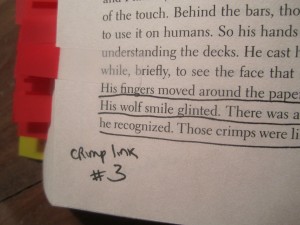 Well, she’s lying, in her friendly way. What she can “feel” are the little crimps or nicks she makes with her fingernails. In story 16, Lipsha, handling King’s cards, also starts crimping them. He learned the method, he tells us, from Lulu, when he worked in the senior center where she lives.
Well, she’s lying, in her friendly way. What she can “feel” are the little crimps or nicks she makes with her fingernails. In story 16, Lipsha, handling King’s cards, also starts crimping them. He learned the method, he tells us, from Lulu, when he worked in the senior center where she lives.
She’d learned to crimp, that is, to mark your cards with little scratches and folds as you play, when she started losing her eyesight.
Watch Erdrich freight the link. When Gerry shows up in King’s apartment and the mood grows ominous,
His fingers moved around the paper edges, found the nail nicks. His wolf smile glinted. There was a system to the crimping that he recognized. Those crimps were like a signature—his mother’s.
That’s how Gerry–who was in prison when his son was born and given away–confirms that Lipsha is that son.
Let the reappearance of a link reveal character, increase tension, or further the story.
Let links be kinetic by changing with every reappearance.
A second reference to an event can be a lie, a different version, the second half of a story that the reader thought was complete, or a misunderstanding.
Consider the burning of Lulu Lamartine’s house.
Nector Kashpaw, in story 7, leaves his wife for Lulu, finds Lulu’s house empty—and accidentally burns the house down by setting fire to a letter he meant to leave there.
Lulu—who is fond of stating the truth in ways that make her look good—says in story 15:
How do I know? How can I say it was Kashpaw who lit my house?
I can say so because of what I saw in his eyes when I looked deeply through him…My house was burning in his eyes, and I was trapped there, alone, on fire with my own fire.
That makes her sound deeply intuitive, but it’s not true.
In story 13, Lipsha overheard Nector Kashpaw tell Lulu in the Senior Citizens laundry room,
“The letter was what started the fire…I never would have done it.”
Nector’s half-senile, so Lipsha ignores this out-of-the-blue remark. But it’s clear that Lulu filed it away.
Or consider Henry Lamartine Jr.’s apparent suicide.
In story 10 (shattering—The Red Convertible), Henry has returned from Viet Nam and cannot readjust. He is out with his brother Lyman, who’s been trying to engage him with the gorgeous red Olds convertible they’d bought together, when Henry leaps into the rain-swollen river. It looks like a playful leap, but Henry doesn’t resist the current, and he drowns. To a Western reader it looks like suicide.
Lyman then pushes the car into the water. From the poetic writing he seems to be giving the car to his brother, as if unable to own it alone.
Five stories later, Lulu tells us more calculated, less poetic version of Lyman’s action.
“It was an accident,” Lyman said, coming in the door. He looked half gone himself. I threw an afghan on his shoulders.
“Don’t say nothing.” I led him over to a chair. He sat in shock.
“The car went in,” he said. “Out of control.” There was a false note in his voice and I knew he had planned to say this. I also knew that no accident would have taken Henry Junior’s life.
My point is that by making the link kinetic – changing the version of an event when the telling resumes – Erdrich reveals and deepens character. We understand now that Lyman wants to save Henry from appearing to be a suicide. We understand that Lulu does not like to talk about emotional matters, and also that she will be his accomplice in this. We understand that mother and son—Lyman and Lulu—can communicate a lot with few words. And, finally, we understand about Henry that no river could kill him without his consent.
That’s an enormous amount of information in very few lines. It also results from the fact that Louise Erdrich is fully in control of the gap between the first and second appearance of the link:
Engineer that gap. Make it shapely.
I could have given it more thought in Normal People.
In my collection, I show Leah, my protagonist, at age 15 with her father dying, and it’s pretty clear that this is shattering for her. Four years later she remembers the smell of her father’s shirts, which she saved. A couple of reviewers said, hey, wait—when did her father die? They felt stranded in the gap. I didn’t know what they meant till I close-read Love Medicine.
Louise Erdrich may let characters disappear for years and then reappear, but she establishes early on that these are her rules; the reader never feels abandoned between stories. It helps that she is writing about a large community, not one main character. This too lets her move around freely.
Tim O’Brien writes about all of his characters in his first story (“The Things They Carried”), then is free to circle around the group and write about individuals as he sees fit.
Imagery can be a link if it recurs often. Erdrich uses water and bridges; here are examples of the many water links.
Story 7: “I was a flood that strained bridges.”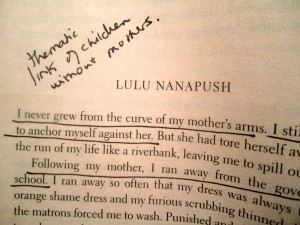
Story 8: The waxed floor “rolled and gleamed like a fire lake between us. And it deepened.”
Story 9: “It was, to Henry, as if she had crossed a deep river and disappeared.”
Story 10: “And then there is only the water, the sound of it going and running and going and running and running.”
Theme can be a link. Erdrich’s children are often motherless, raised by adoptive mothers; her sons are sometimes without fathers. Death is shown as something to travel toward, the way “crossing water” can mean both dying and coming home.
Cathy Day, my co-panelist, has blogged on linked stories from a different angle.
People in trouble
My friend Natalie Baszile and I are studying Away, a novel of such narrative thrust that only on reread, pen in one hand and phone in the other, are we starting to understand how complex it is, how many things Amy Bloom is doing at once.
We’re not going at this systematically, just passionately. Natalie says that examining Away 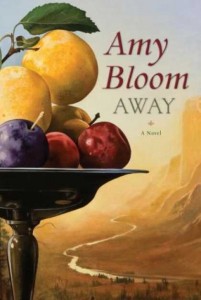 is like standing on a tapestry, stunned by jewel tones, so it’s hard to know which threads to scrutinize first. I think this will become the Away blog for awhile. Not systematic. Just passionate. Pulling one thread at a time.
is like standing on a tapestry, stunned by jewel tones, so it’s hard to know which threads to scrutinize first. I think this will become the Away blog for awhile. Not systematic. Just passionate. Pulling one thread at a time.
Here’s the official Random House summary, which is no substitute for the book.
Here is the first paragraph in its entirety (page 1 happens to be a page we looked at last night):
It is always like this: The best parties are made by people in trouble.
I love what she dangles before us in that first line: people in trouble. If there’s one thing I want to read about—
And here are the first two sentences of a second paragraph that could almost fill a page:
There are one hundred and fifty girls lining the sidewalk outside the Goldfadn Theatre. They spill into the street and down to the corners and Lillian Leyb, who has spent her first thirty-five days in this country ripping stitches out of navy silk flowers until her hands were dyed blue, thinks that it is like an all-girl Ellis Island: American-looking girls chewing gum, kicking their high heels against the broken pavement, and girls so green they’re still wearing fringed brown shawls over their braided hair.
Such urgency, right up front. Spill, spent, rip, dye, chew, kick. Girls, crowded together, hungry for work. But here’s the part Natalie and I are trying to understand: How, in two sentences, does Bloom sweep across so much time and space?
Here’s what she packs into Sentences 2 & 3 of the book. It’s like fitting a taxicab into a suitcase:
Lillian is a Jewish immigrant from Eastern Europe or Russia (her name, and the theatre’s, tell me this). In five weeks she’s been working hard not just at sewing but also at keenly marking the differences between girls with the shtetl in their clothes and hair, and girls who’ve shed it. Bloom shows me that Lillian has sharp eyes, because of how she notices detail. She shows that Lillian’s mind works as fast as her seamstress-hands, because of how data from the Bloom/Lillian POV comes flying obliquely at me.
Which is to say that Natalie and I have opened the suitcase and examined the taxicab but we can’t quite figure how Amy Bloom got it in there, or how to pack such a bag ourselves.
Here is another example of sweep, this time from the brief POV of Frieda, the cousin with whom Lillian lives (p. 13).
She would not ask to bargain with Italians every month for the privilege of doing piecework in her apartment, but she sees it all as part of the great ladder upward. She feels the smooth, pale wood under her hands, she sees her feet settled firmly beneath her; she dreams almost every night of her spiritual home, Fifth Avenue, and she is strolling with her friends, well-dressed women flashing silk ankles
and strapped shoes, accepting compliments from handsome, prosperous, cigar-smoking men (clean-shaven, well-spoken men), climbing the polished marble steps to her brownstone, in which Frieda waltzes from room to room, skirt flaring as she catches a glimpse of the gleaming porcelain fixtures in her modern bathroom…
This sent me to my beloved first printing (not first edition) of Mystery and Manners, in which Flannery O’Connor analyzes that now-famous sentence about Emma Bovary playing the piano. Flaubert wrote:
Thus shaken up, the old instrument, whose strings buzzed, could be heard at the other end of the village when the window was open, and often the bailiff’s clerk, passing along the highroad, bareheaded and in list slippers, stopped to listen, his sheet of paper in his hand.
Flannery, describing what Flaubert pulled off, might have been speaking of Bloom and Frieda:
The more you look at a sentence like that, the more you can learn from it. At one end of it, we are with Emma and this very solid instrument “whose strings buzzed,” and at the other end of it we are across the village with this very concrete clerk and his list slippers.
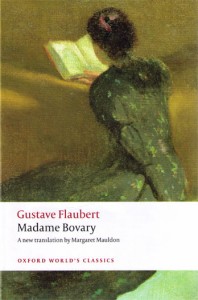 Critical, says Flannery, because “Flaubert had to create a believable village to put Emma in.”
Critical, says Flannery, because “Flaubert had to create a believable village to put Emma in.”
Just so with Frieda: At at one end we are bargaining with the Italians for piecework, and at the other we are on Fifth Avenue with “silk ankles” and a porcelain sink, and the result is the believable city of poverty, striving, and wealth in which Lillian Leyb has landed.
Don’t worry; there will not be a quiz. I write this stuff because I’m obsessed.
sainted, salient, saliva, sallied, sally
Why am I intoxicated today by a 17-page alphabetized list titled “Words That Should Not Be Used in Fiction, a Selection” (and is exactly what it sounds like)?
L
Label, labia, labile, labored, laconic, lair, lambent, lame, language, lapel, lapels, largely, largess, lash, lashed, latter, laud…
Oh, stop nodding off. Could it be that the list is true, that it’s hard to use lapels without resorting to grabbing by and boutonnieres and other clichés (“resorting to cliché” being itself unforgiveable; forgive me), that lambent works too hard, that lashes are predictably long and dark unless you sear them off in an explosion?
These 17 pages open a book that may remain fantastically obscure—Words, by Andy Devine—and not just because the cover has about as much visual presence as a cloud.
Devine is to writer Michael Kimball what de Selby was to Flann O’Brien in The Third Policeman: an invented genius, exceedingly bizarre. (My mentor, Jim Krusoe, said of The Third Policeman: “This book is so good it’ll make you want to pee in your pants,” a line I stole for a story. And he was right.) Devine, a “conceptual fictional writer” and alphabetical essayist, writes novels and stories, then implodes them into lists of words and punctuation marks. Rigorous about revision, he whittles a couple down to their titles. His life’s work is the subject of much study. (Surprised?) Accordingly, Kimball, as editor, adds to this collection a scholarly afterword, quoting from rare Devine interviews; and I am amazed to find myself joyful over the whole thing.
Here is a snatch of commentary on two lists that launch the book, the second, of course, being “Words That Should Be Used In Fiction, a Selection.”
Of course, these were not essays in a traditional sense. They were both simply lists of words, but it was clear that the lists of words collected into an argument that was an implicit critique of fiction. Devine confirms this in the Maday interview (2009): “I’m talking about these words in relation to fiction. Nonfiction is another matter.”
This feels like getting my brain rubbed right through the dura mater.
Okay, so this is really not you. You are not vastly amused by Devine’s theory that “word choice was one of the intial points of failure for so much fiction and that by avoiding certain words that failure could be avoided, or at least delayed.”
May I then recommend nine pages in the middle titled “A Grammar For Fiction Writers,” which is not a grammar at all; it is the author speaking truth to writers, with periodic rants about punctuation. It’s in list form, of course. The first line got me out of the apartment this morning to do my pages in a coffee shop, and may become one of my mantras, which is more than worth the $8 cost of the book.
Herewith, a Selection.
Fiction writers are only fiction writers when they are writing fiction.
Fiction must be rendered. Revision creates art.
Every work of fiction can be improved.
It is important for the fiction writer to have a sense of purpose even if that sense of purpose cannot save the fiction writer.
The reader should never know what the next sentence is going to be.
And just to keep you off balance:
Words with prepositions in them—downstairs, downtown, inside, outside, upstairs—are good words. Write fiction about people going inside, outside, upstairs, etc.
I don’t really get that, I don’t even agree with it, but the book made me bizarrely happy. Revision creates art—oh yes. Back to work.
Risks and excuses (and more dog therapy)
This is what I know about myself: the safest thing I can do is take a risk, while the riskiest thing for me is to play it safe.
–from Poet Mom, the blog of poet January Gill O’Neil, author of Underlife
Perversely, when I am several months into writing a story, or several years into a book, I stall. And not just stall. I flee. This happens just as the thing starts to seem like a genuine piece of narrative—albeit still a rambling piece of crud, but one that might soon start to crystalize.
It would be lovely to think that my subconscious is saying, Honey, just let the manuscript percolate for a few months. But I’m suspicious. I think dread of some kind is involved. Dread of failure? Fear of success? Whatever’s going on down there in the writer’s basement, I’m playing it safe, taking no risks: not writing. And the manuscript, far from percolating, becomes a distant object.
I have marvelous excuses. An intensive book tour. Can’t write in hotel rooms; bad ergonomics kill my hands. A friend’s chemo, necessitating a two-week trip. Another friend’s novel, which I line-edited with much pleasure for two weeks. My mom’s fourth hospitalization  (involving more dog therapy, of course—that’s Pippin in dreamy splendor at the foot of the bed) and my six-week relocation to L.A.: Who could work? I’m never home; it’s a theme. My shiny new blog. There’s more; shall I keep going?
(involving more dog therapy, of course—that’s Pippin in dreamy splendor at the foot of the bed) and my six-week relocation to L.A.: Who could work? I’m never home; it’s a theme. My shiny new blog. There’s more; shall I keep going?

In Santa Monica’s Diesel bookstore this evening I was amazed to see, as if for the first time, that some writers come out with books on a regular basis and some do not, and that I really have only two choices for my sparse free hours and bad hands: blog-email-Facebook (which has brought many new writers into my world), or work on the terrifying half-done novel. In Diesel, finally, I saw it as a choice—for now, at least, after five months of book-travel and caregiving. And so I hope to unplug, though not to a Luddite extent, and get back in near-daily touch with the novel. I feel almost Seussian about this vow: I will write it on a train, I will write it in the rain, I will write it in my bed, I will write it in my head. Most important, I promise to take the risk of writing it on the bad days.
(Dog therapists trained and provided by the nonprofit Love on 4 Paws.)
